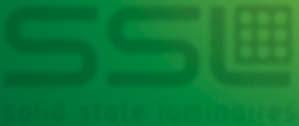
10 minute read
Tubes Deliver Daylight, Help Cut Energy By 23
from commARCH - June 2014
by IdeaSoil
light everywhere, and some of the classrooms didn’t have any exterior windows. We knew right away that daylighting would be a big part of this project.”
“We decided to expose the tubes of the daylighting systems in the lobby as a way to celebrate the sustainable aspects of the Center for Environmental Sciences. Students and faculty wanted them to be very visible so they could also serve as a teaching tool on sustainability. There are even signs posted throughout the building that point to the various green aspects,” Carver said. “The faculty was thrilled with the outcome and so was the administration and facilities-management team.”
Advertisement
Additionally, the space uses solar panels, high-efficiency lighting (for non-daylight hours), occupancy sensors, and real-time energy monitoring. The entire renovation was 21,000 sq. ft. within the 47,500-sq.-ft. Carr Hall at a cost of $784,000. The energy savings of 23% will result in expected annual savings of $13,000, according to DOE estimates.
The project was designed to earn LEED Gold Certification for Commercial Interiors and to create a sense of community and collaboration. The Richard J. Cook Center for Environment Science, as well as all of Carr Hall, is LEED Gold Certified.
Allegheny College was recognized in May 2014, by the DOE for its achievements in the Better Buildings Challenge and for reducing energy intensity by 7% across its entire building portfolio. The announcement was made at the National Better Buildings Summit in Washington. Better Buildings Challenge partners are demonstrating progress toward achieving 20% energy savings in 10 years, with annual energy savings of $300 million.
“By committing to cut energy use by 20%, Better Buildings Challenge partners are demonstrating how businesses and organizations are reducing our nation’s energy bill, creating American jobs, and protecting the environment,” said David Danielson, assistant secretary for energy efficiency and renewable energy at the DOE. “With commitments representing more than 3 billion square feet of floor space, these partners are leading the way to a cleaner energy economy.”
Allegheny College was among seven colleges and universities nationwide to join the Better Buildings Challenge when it was first announced by President Barack Obama in 2011, and its continuing commitment to energy efficiency and sustainability is demonstrated by the renovation of Carr Hall. CBP
DATA CACHE
Want more information? The resources below are linked in our digital magazine at cbpmagazine.com/digital/jun2014.
Circle 8 on the Reader Service Card.
For more information on daylighting at Allegheny College, visit For more information on daylighting at Allegheny College, http://sites.allegheny.edu/news/2012/10/12/richard-j-cook- http://sites.allegheny.edu/news/2012/10/12/richard-j-cook- center-for-environmental-science-is-dedicated-in-ceremony-at- allegheny-college
For a video on sustainability at Allegheny College, visit For a video on sustainability at Allegheny College, visit http://www.planetforward.org/idea/allegheny-college-deep- http://www.planetforward.org/idea/allegheny-college-deep- infrastructure-sustainability
For more information on daylighting and Solatube products, visit For more information on daylighting and Solatube products, visit http://solatube.com.
Visit the ACUPCC website to lean more about the Presidents’ Climate Commitment program: http://www.presidentsclimatecommitment.org
eCoveLine XL Wet
This environment-friendly exterior LED cove luminaire is powerful and versatile. It’s sealed aluminum housing and IP68 connectors can handle harsh conditions. 1, 4 and 6 foot lengths replace large cumbersome exterior fixtures and extra setup. Integral power supply means no remote driver. Universal orientation installation.

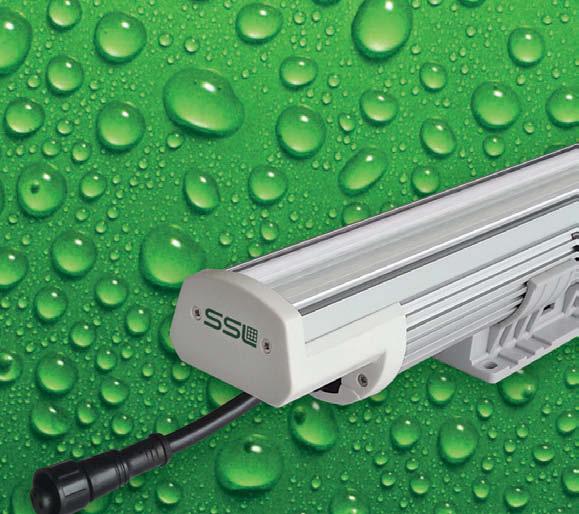
877-SSL-GREEN



info@solidstateluminaires.com
SolidStateLuminaires.com
Wet Cove
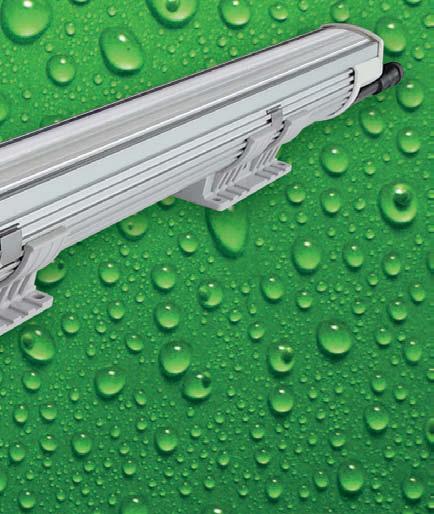


27K 3K 4K3K 4K
EDITORS’ CHOICE
Phone entr y system
C V-TAC400:
• Integrated auto-dial control telephone entry system • 500-name directory • Also provides card access control

CV-TAC400 is an integrated ADC auto-dial-control telephone entry system that combines telephone entry and card access. Telephone entry features include a 500-name directory, electronic display, and master/slave confi guration for as many as three panels. Access control features include HID/AWID format card reader, as many as 3,000 user codes, and elevator control. Both systems use a common confi guration and reporting software platform.
Camden Door Controls, Mississauga, Ontario Circle 73
Inswingcasement hurricane series AW-rated aluminum G061 Impact series casement inswing energy-effi ciency hurricane window system passed the Missile type D test. Designed to increase energy effi ciency and reduce heat fl ow and air leakage, the windows are said to control thermal convection at the edge of the framing while the hollow cavities and thermal isolation enhance system insulation.
Peerless Architectural Windows and Doors, Ft. Scott, KS Circle 75
Glazed natural ventilators Colt Group’s Firelight glazed natural ventilator installs in a glass atrium or directly onto a building’s roof. The dual-purpose product provides ventilation and smoke control. Available in a singleor double-leaf design, the system has control options for automated climate control.
The Bilco Co., New Haven, CT Circle 77
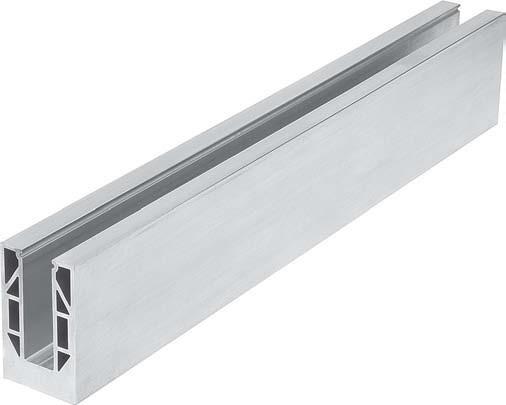

Glass samples SunGuard glass sample system provides a way to evaluate the company’s expanded portfolio of products and coatings. Examples of all coatings are included.
Guardian Industries Inc., Auburn Hills, MI Circle 74

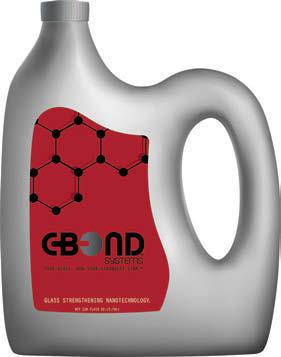
Water-based glass technology
C-Bond is a non-toxic, water-based nanotechnology said to increase the strength and fl exibility of glass, enhance the adhesion of window fi lm, and create an invisible protective barrier resilient to high-impact force and severe threats. The bonding agent penetrates molecular fi bers below the glass surface to increase the structural integrity of the glass system as a unit. On impact, no shards/pieces are said to escape the immediate area.
C-Bond Systems, Houston, TX Circle 76
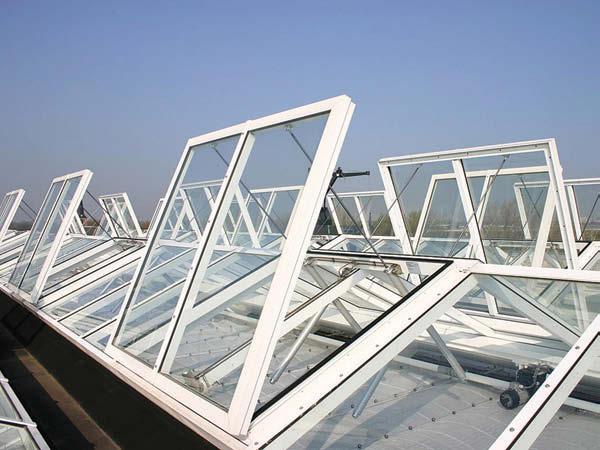
Railing base shoe The 8B series square base shoe for glass railing systems is 30% lighter than its predecessor and qualifi es for LEED projects. The shoe is surface or fascia mounted for use with the company’s GRS Taper-Loc dry-glaze glass railing system.
C.R. Laurence Co. Inc., Los Angeles Circle 78
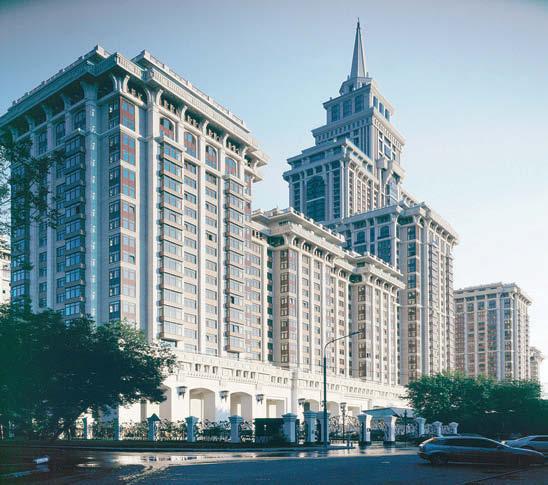

From dorm room to classroom
Window, door line Teutonic series window and door line includes fi xed and tilt-turn windows, tilt and slide doors, and outswing hinged doors. The steel-reinforced uPVC products are said to meet requirements for energy effi ciency, occupant safety, and low maintenance. Applications include hospitality, multi-family, and mixed-use projects.
Kolbe Windows and Doors, Wausau, WI Circle 79
HOLE Inspirations
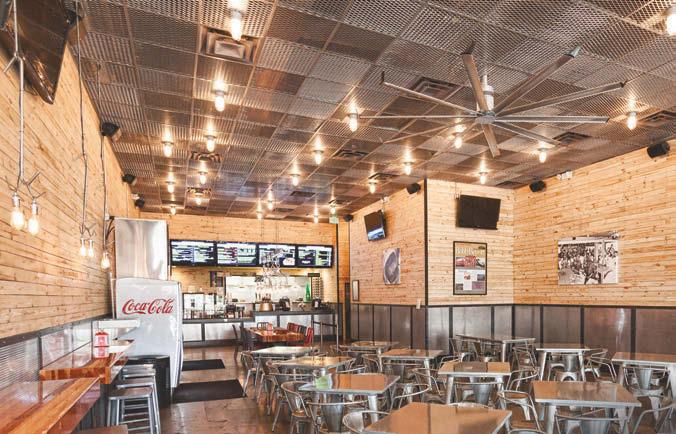
BurgerFi
EXPANDED (Ceiling Tiles)
PERFORATED
(Wall Cladding) McNICHOLS has a large inventory of Hole Products that offer sustainable, functional and aesthetic solutions for both industrial and architectural projects. We are ready to serve you at 866.754.5144 or mcnichols.com.
Inspired to Serve!™
McNICHOLS Industrial & Architectural Hole Product Solutions since 1952 866.754.5144 | mcnichols.com
Scan to see more HOLE Inspirations turn to maxxon For best in class Floor solutions

For renovation or new construction on college campuses, Maxxon offers a complete line of underlayments, sound control mats and moisture mitigation products:
• Used for fire ratings, floor leveling and sound control • Gypsum Underlayments • Level-Right Self-Leveling
Underlayments • Acousti-Mat Sound Control Systems • Moisture Vapor Barriers • More than 100 UL Fire Rated Designs • Documented sound tests over a variety of assemblies • May help contribute toward points for LEED ® project certification

Learn more:
800-356-7887 info@maxxon.com www.Maxxon.com
© 2014 Maxxon ® Corporation, all rights reserved.

Thomas Jefferson Univ. and its affiliated Jefferson Univ. Hospitals occupy more than 20 buildings, including the Dorrance H. Hamilton building, on a sprawling 13-acre campus in Center City Philadelphia.
LEDs Lighten University Energy Load
Retrofit solution that doesn’t look like a retrofit saves energy and maintenance.
Occupying 4 million sq. ft. of floor space across more than 20 buildings on a sprawling 13-acre campus in Center City Philadelphia, as well as other nearby locations, the historical Thomas Jefferson Univ. and its affiliated Jefferson Univ. Hospitals are highly regarded for superior quality, technologically advanced, and compassionate medical care. With the help of a recent lighting upgrade involving highly efficient and easy-to-install LED fixtures from LumenOptix, Montgomeryville, PA, the institution can also rest assured that its facility operations meet similar high standards for energy efficiency, low maintenance, and sustainability.
Overseeing facilities that house cutting-edge research and teaching capabilities within 12 specialized areas, as well as state-of-the-art medical equipment including MRI and gamma knife technology, Thomas Jefferson Univ. energy manager Randy Haines, CEM, CLEP, has long been dedicated to ensuring that operations run as smoothly and as energy efficiently as possible for the many faculty, students, and patients who occupy the space. In that regard, lighting has offered a fertile field of upgrade possibilities. “I’m always looking for opportunities to modernize our systems and have upgraded the lighting in a number of 24/7 areas over time, such as our elevator cabs and stair towers,” Haines said.
But another even more high-profile opportunity presented itself in 2013, when the existing lighting technology in the lobby of the university’s glass-enclosed Dorrance H. Hamilton building, built in 2007, began to reach its natural end-of-life. Lit by a series of two-lamp, 26-W plug-in compact-fluorescent lamps (CFLs), “all of the lamps in the lobby were starting to fail and, with LED prices coming down and helping the economics to make sense, we realized that we could replace an entire fixture with a new LED solution for not much more than the cost of replacing just the lamp and ballast components,” Haines explained.
The 15-ft. height of the atrium ceiling was another consideration that made LED technology appealing. With a 12,000-hr. life, which equaled just one to two years of operation within a 24/7 operating environment, the existing CFLs required frequent replacement. “Our maintenance crew was constantly replacing burned-out CFLs, and this wasn’t the simplest of tasks. We needed to use a high-reach apparatus to access the fixtures, so the process of replacing a lamp and/or ballast took our team almost an hour per fixture. Because of various classes and events being held in the lobby, it was often hard to schedule time to perform these change-outs without disrupting operations,” he said. As a result, Haines wanted a solution that would provide optimal lighting, reduce energy consumption and costs, and simplify maintenance within the 66-fixture atrium application.
AN OPTIMAL SOLUTION Tasked with recommending the most appropriate LED technology for the Hamilton Building’s lobby, Joe McGowan, veteran sales representative with Illuminations Inc., an industrial and commercial lighting manufacturers’-representative firm located in West Chester, PA, knew the LRD (LED Retrofit Downlight) luminaire from LumenOptix would serve the facility’s many needs well.
Because the lobby’s lighting incorporated a sophisticated Lutron Electronics, Coopersburg, PA, dimming system that enabled light levels to be controlled for dinner events at night, “we immediately contacted LumenOptix, who assured us that they'd already configured their system for compatibility with many of the market’s most popular and complex controls and dimming systems, especially Lutron’s,” McGowan said. Upon confirming compatibility, “we proceeded to install another three samples so that we could see what the light would truly look like within a square pattern. Following various foot-candle readings to ensure that the lighting was consistent at the floor level, the team felt confident in making the investment.”
The upgrade was completed and, as specified, provided the same 2,000 lumens of light output as the previous CFL fixtures while using half the energy. “Installation was simple; our crew members worked right below the ceiling tile and were able to wire and pop in each new fixture within minutes,” Haines said. “And with a rated life of 50,000 hours, over four times longer than our previous technology, we look forward to 5 to 7 years of continuous and maintenance-free operation with the new LED fixtures.”
A modular LED retrofit solution that enables a downlight of any make, model, or size to be upgraded in just minutes, the “LED Retrofit Downlight luminaire was a perfect fit for the Hamilton Building’s atri
Below. When the CFLs in the lobby of the glass-enclosed Hamilton Building, built in 2007, began to fail, they were replaced with LED technology.

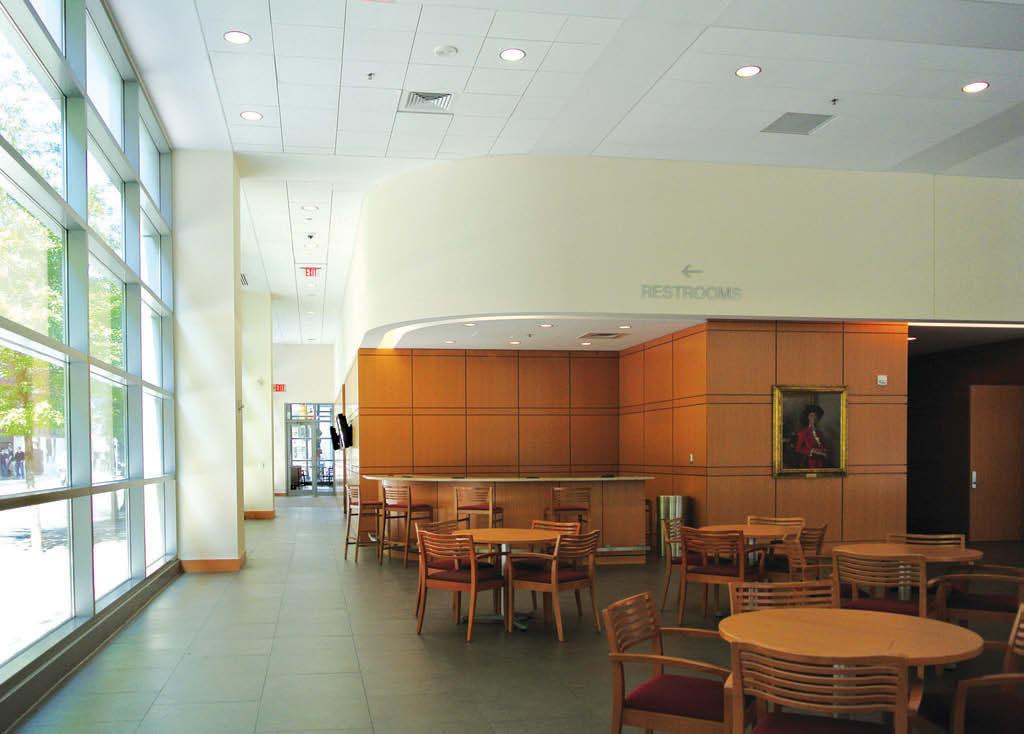
Above. A retrofit that doesn’t look like a retrofit, the replacement LEDs helped to maintain the look and feel of the lobby, at the same time using half the energy of the previous lighting.









